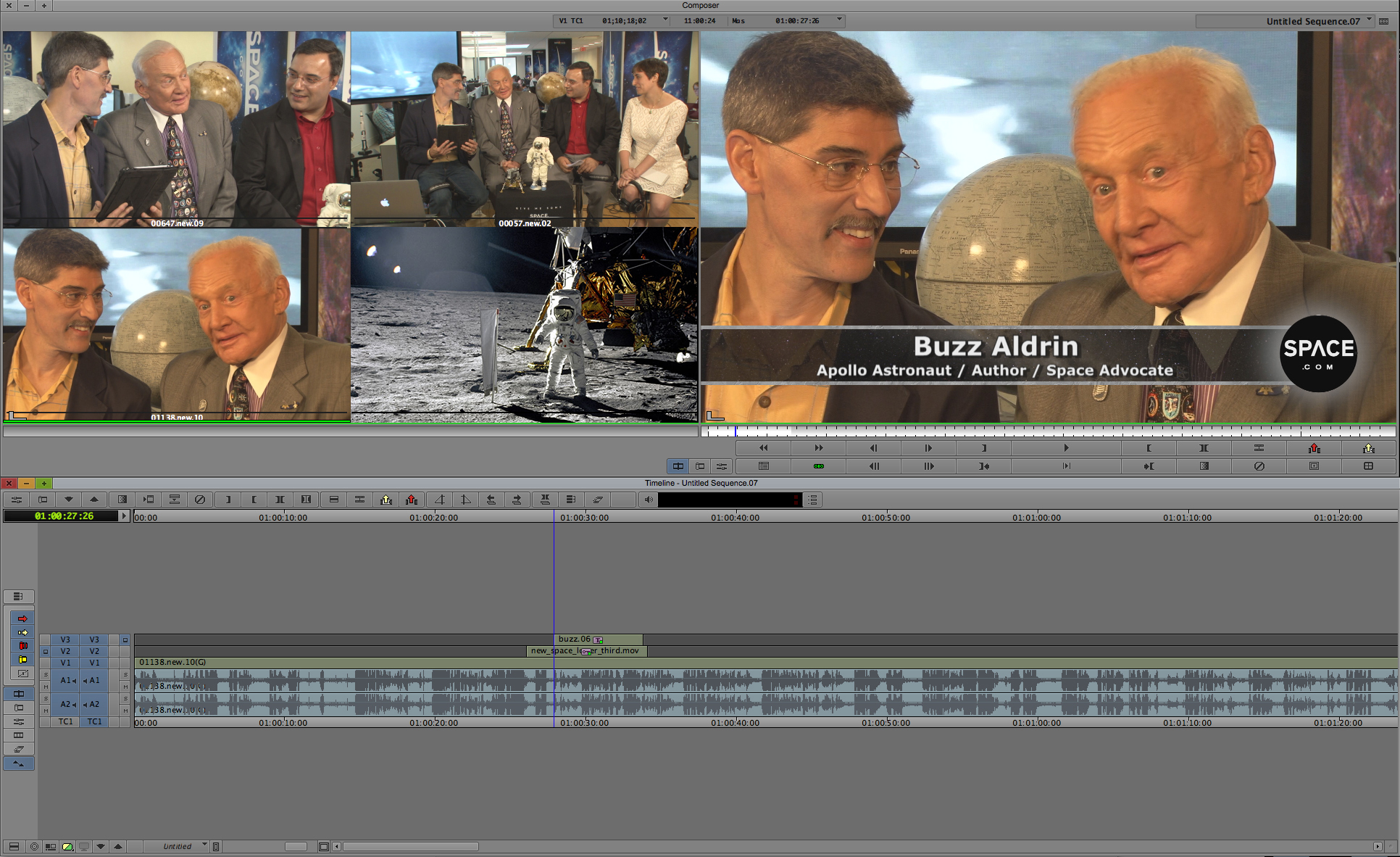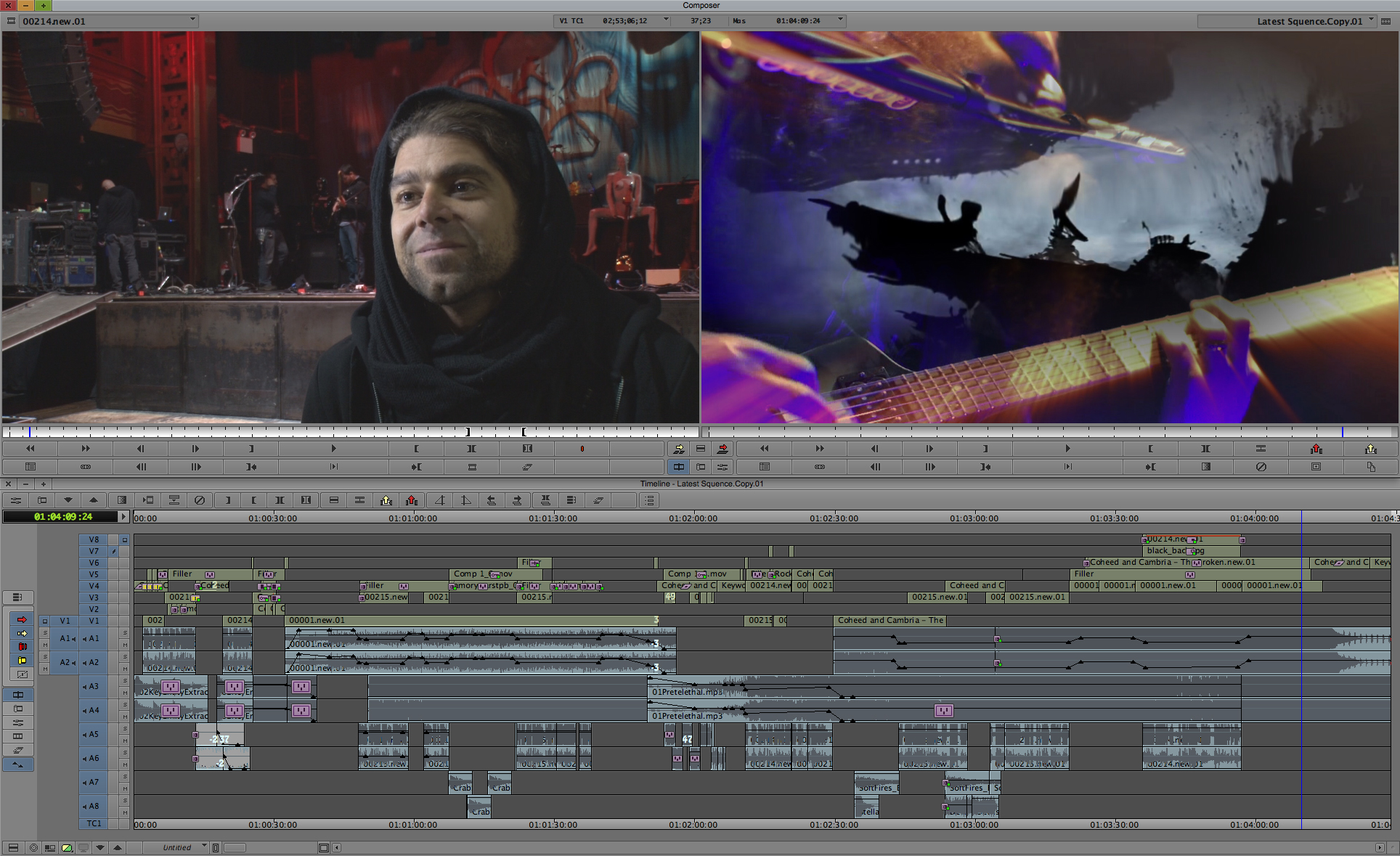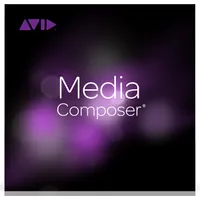A Guide To Professional Video Editing Software
You've read through our analysis of free and low-cost video editing suites. Now it's time to take a look at the industry's heavy-hitters: Avid, Adobe, Apple, EditShare, Sony and Grass Valley. Is there a best? That all depends on what you're trying to do.
Avid Media Composer
Avid Media Composer (Best in Class)
(Mac + Windows)Street price: “…it’s complicated.”
Yeah, I gotta go with Avid Media Composer. This is the default workhorse tool of television and film. Its long evolution has been torturous and expensive for video editors. It has been agonizing and exasperating for Avid’s internal developers. The company has edged near death more than once. But the software is now mature, solid, stable and (dare I say) a little sexy in its own stodgy way.
With your purchase of Media Composer you, today, stand tall upon a huge pile of mangled souls—bruised professional users and wounded former Avid employees—who have fought for a quarter-century (often against one another) to fix bugs and forge the ragged frontier of non-linear editing. You benefit from their years of toil and frustration. Shed a tear. Say a prayer. Salute them.
Now go edit your little tush off. Because, with Media Composer, there's hardly anything you can't do.
But sometimes Media Composer’s way of getting you there is Byzantine. It takes a while to turn a massive ship at sea. Avid has been lagging behind smaller, more nimble companies in several innovations. There’s no lack of engineering acumen at Avid; it’s more about the need to ensure any new feature is compatible with a much larger user-base than most competitors. When those customers are enterprise-class pros (most Avid users are), there’s great demand for stable performance on existing (“sunk cost”) hardware.
Avid’s competitors were quicker to let you work directly with native media formats. Avid began to address this with Media Composer 7’s Avid Media Access (AMA) protocol. But AMA’s implementation wandered down bit of a bumpy road. In Media Composer 8, AMA percolates mixed resolutions much more smoothly.
You can drag and drop media files into a bin—which initiates an Import, transcoding and cloning as needed. Holding down modifier keys (Alt on Windows/Option on Mac) instead conjures an AMA link, essentially creating an Alias in your bin and accessing the media without importing. You can color-code such clips, so a glance at your timeline will tell you what’s native in the session and what is linked. All of this “AMA-ing” (yes, it’s now a verb) can speed your workflow, as long as the needed media drives are connected during your final Export.
Get Tom's Hardware's best news and in-depth reviews, straight to your inbox.
Avid now also lets you transcode in the deep background, meaning you can set a list of mixed-media clips to wash, dry and fold themselves any time the CPU is active, even if you quit Media Composer entirely. It reminds me of the old school days of batch-process code compiling, but now with terabytes of 4K, 3D and HDR.
But the speed and crashworthiness of your workflow is still inversely proportional to the amount of transcoding needed. If you can set your project up to ingest a single format, Avid will fly like the industrial strength power plant you have a right to expect. Mixing resolutions puts a tax on your hardware; usually not a big deal, but it can get seriously squishy if you’re on an older CPU.
One great reason to work with 2K or 4K sources is Media Composer’s ability to re-frame (crop) radically in the edit, while still maintaining full 1080p HD resolution. It’s called Frame Flex. It saves you save time in the shoot and preserves your creative options because you can do your critical framing in post. If an actor threw down an inspired (but very subtle) expression, you can get the close-up needed to sell it. Not to mention the product shot for the agency producer to whom no brand mark is ever big enough…
But let's say you want to stay in 4K or UHD all the way. The v.8.3.1 release of Media Composer will support you. You can either work with these super-heavy media directly on the timeline, or cut using proxy-files and only call the native camera files on export. Newer cameras with huge sensors and high frame-rates make fat files. A RED 4K cranking at 59.94p will spit uncompressed video at more than 700MB per second. Even with ProRes compression, your NLE is fielding a stream of over 125MB/sec. if you have enough hardware horsepower, Media Composer will cut it.
Directors of Photography are staring to work with Look Up Tables (LUTs) right there on-set. This lets them capture full-range (but flat looking) files, yet see what proper profile color grading will do to them in post. Thus, the DP, the Director, the Producer, the Talent can all see the shot in the finished look of the film right there, without having to commit to anything.
Editors develop their own style of cutting. Like playing a musical instrument, pros get their best performances when wailing on their own axes. Media Composer’s highly customizable User Profiles feature lets you set up your bench the way you need it. And you can take it with you onto any Media composer system. I can’t stress how important this is for those who do this day-in, day-out. When it’s right, the interface melts away and you feel like you’re sculpting movies with your fingers around the images, like the best moments of cooking, molding modeling clay and making love, all rolled together. Well, something like that anyway.
In days gone by, a complex Media Composer session looked like a train wreck of overlapping Bin windows and Tool palettes. Since v.6, the software has gone to a tabbed navigation look that allows you to step through bins with drop-down mini-menus. You may also nest folders hierarchically inside of Bins. Doing so makes a big session manageable, even on a laptop’s limited screen real estate.
Looking at a Bin in Frame View lights up your visual cognition circuits. Thumbnails of clips appear. You can play each clip right in the window. And, yes, you can set the thumbnail frame. The flow of the show immediately starts coming together in your mind. You can drag clips around to create a quick and dirty Storyboard, which is handy for getting approvals from bosses above or for assigning “scut-work” to colleagues below.
Switching that same Bin to Script View lets you type or paste as much text as you want into an annotation bar with each clip. Dramatic script, documentary transcript, take-selection, director’s notes; whatever you need to see the narrative flow of a great show take shape before you.
Audio in Media Composer is taking a ridiculously long time to become fully integrated with ProTools, Avid’s industry standard audio DAW driver. A bit of company history perhaps explains this. Avid (East Coast) acquired the Digidesign (West Coast)—creator of ProTools—two decades ago. One was sample-based, the other frame-based. Culturally, Avid has long been a house divided.
But the matrimony is finally flowing. The mixer in Media Composer looks and feels like a toddler-level ProTools. The ability to set audio Clip Gain right on the time line, event by event, grew into Media Composer (and Avid’s ProTools 11). This is handy, letting you optimize each bit of sound as you work, building your mix as you go, without writing fader automation. And Media Composer has finally added a Master Fader to its mixer, at last replicating the most obvious feature of all analog audio consoles since the 1930s. Better late than never, Avid.
You can drop RTAS plug-ins across Avid tracks, but you may have to render them out to hear them. And sometimes they will invisibly hang; if your ears aren’t wary, you’ll miss the fail.
It took Avid coders many years, but they’ve finally got over acting like stuck-up, self-centered computer nerds and learned to speak some actual television. And film. Along the way, the Avid product marketing team realized how bright their user-base actually was. Avid unbundled its systems (though way too late) to let users jockey their own hardware configs.
Font-work, for a long time, was a no-win choice of the puerile Avid Title Tool or the quirky Avid Marquee Tool. But now Avid FX is ratcheting up to its competitors' market level in the craft of text-over-video. Avid has also opened itself to the third-party specialist world; New Blue’s Titler Pro and VisTitle (Windows-only) are the go-to choices. And, of course, you can wormhole your way out of the Avid universe to the venerable Adobe After Effects. If you need custom 3D, you’ll need to bounce outside of Avid (into something like Blender), then import your final result.
Media Composer is industrial strength software, battle tested in high-pressure broadcast shops and tweaked in response to finicky film directors. Along the journey, Avid developed powerful metadata search tools to help you organize your artistic endeavors and access your assets amid your growing library.
Pushed by Adobe into the realm of subscription software, Avid now offers Media Composer for $49.99/month. Or you can buy it. If you already own it (I do) you can "lock in your perpetual license for $299.00 and get access to every software update plus standard Avid support for the next year—or subscribe for $39.99 per month for the first year." A cynical unpacking of the qualifiers and hidden gotchas behind that bit of marketing-speak suggests Avid would really, really like you to slip from privileged owner to addicted renter status, though it doesn't have the fortitude to insist upon your servitude. At least not just yet.
A less cynical perspective on Avid’s pricing reveals that it lets you grow or shrink your commitment to Media Composer, based on the changing needs of your enterprise. If you suddenly expand to need, say, 20 editors to cut your reality show footage, you’ll want to transition to a floating server license deal. If you are building down after a long-running production has sunset, Avid will step down with you to manage your sunk costs.
More pertinent to most of us, the Avid subscription model will likely reduce the cycle time between upgrades and bug fixes. If you own Media Composer now, you should spend the $299 in 2014 (or by the end of your current support plan). If not, you will probably find yourself re-buying the whole package next year (it’s $1299 now).
Of course, there’s nothing wrong with freezing your platform at its current level of capability and running it until you can no longer replace the hardware or patch the software. You’d be driving down a one-way street into an evolutionary cul-de-sac. But not everybody likes to live downtown.
Avid support is—and has always been—surprisingly annoying. Though you may pay into the (exorbitant) “Support” assurance plan, prepare yourself for the bum’s rush if you are not a broadcast network or large post-production house.
I recently had the experience of waiting 28 minutes for an Avid support rep to answer his phone. Then I got to watch him remote-access my desktop and witness my issue first-hand, only to have him send me e-mail four days later demanding that I take screenshots of the problem he saw in real-time. And I’m still waiting for the fix. Unconscionable!
In what is perhaps an effort to act with more egalitarian morality, Avid is apparently pivoting to a “Googlesque” model of customer self-help. But Avid lacks Google’s deep pockets to resource the development of the needed online infrastructure. Until it gets there, if you want to solve a problem related to Avid’s architecture, you pay them to fix it.
We are focused on editing tools in this article. But know that Avid is a strong player in media management, enterprise-class workflow, distribution and play-out technologies; the stuff that comes before, behind and subsequent to your picture cutting wizardry.
If you are delivering to television, you won’t find better export compatibility. Right now, chances are your export will be transcoded at least one more time for play-out to air (by something like Grass Valley’s STRATUS cloud). But it is theoretically possible to play out of Avid, direct-to-air, via Avid’s Unity ISIS (Infinitely Scalable Intelligent Storage) system. If, say, you were starting your own news channel, you’d want to digitize once—at the camera—and be able to whip that asset to air, live or on-demand, with added value or simply raw. You could do it all in Avid-land.
As the media world spins into cloud creation, no work of art is ever truly new or wholly finished. But Avid can be there, powering your process, at every step past the lens.
Current page: Avid Media Composer
Prev Page A Guide to Professional Video Editing Software Next Page Adobe Premiere Pro Creative Cloud-
Spoogemonkey The absolute worst article on Tom's I've ever seen. Horribly overwritten and full of useless, embarrassing dribble. Pathetic.Reply -
randomstranger9 Commenting commentary... who are the commentariat who could comment on comments? A commenter!Reply
See how annoying this kind of writing is? -
HormusPeston I loved this article. I've been editing since the days when tape was pre-striped and when "hit record" required a mental countdown during pre-roll. Like most professional editors, I can edit on pretty much any system that you throw at me. Placing the playhead where you want it and knowing the equivalents of XCVB and match-frame gets 90% of the job done. IOJKL is standard -- the Avid standard. I remember the older FinalCut versions had absolutely idiotic shortcuts -- I think D was mapped to "Duplicate clip" or something silly...Reply
Cutting on the Avid is like being married: she grows on you and nothing else feels right. I've flirted with X, with Premiere CS6 and many others Incite, Edius, Media 100 but I still love my Avid. I carry my settings and jog shuttle with me.
I grinned broadly at the author's comparison of Lightworks to a flatbed! Of course it is! This is the only review I have read that distinguished between a young editor willing to learn new software and an old dog.
Thank you.
-
beetlejuicegr New way of writing an article i have to admit. I guess the writer wanted to show the creational side of it, unlike the tools making you "send a low res pic on a small mobile screen to get the ok" as he says somewhereReply
Well sure after thousands of montage you will feel that way. -
joe_newbuilder Each of these softwares targets a different market segment and has different requirements. Some software no matter how great has no traction in that market. It is pretty important to be using the tools that others in your industry expect.Reply
It is really important to see how these programs work with finishing tools. You really should use an editing program to do effects and color work because most of the time it limits the ability of professionals to collaborate using much higher quality tools geared to those tasks.
As far as markets I have seen Avid, Final Cut and Premiere used in feature motion pictures. Projects are commonly shared between parts of production. So the editors who are doing all the logging and tagging of performances may not be doing the final cuts of the work. Each platform as a way of exporting tagging and conforming media so that when you move from one system to another each person can know they are looking at the correct clips.
For episodic television Avid is all I see. The incredibly short schedules for TV pretty much live on the sharing infrastructure setup between AVID stations.
That is also market dependent, I have seen European shows edited on Quantel.
Unless you are big enough to make your own way, or so small you won't work with anyone else it's important to use what others in your field use


